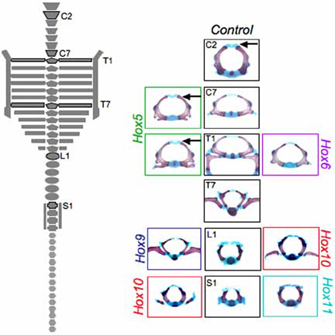What Do Homeobox Genes Code For In Animals

Figure 2: Changes in specific vertebral elements for the Hox5, Hox6, Hox9, Hox10, and Hox11 paralogous mutants.
On the left side of the panel, a diagram of the centric skeleton is shown, with specific vertebral elements shown in the right console marked (C, cervical; T, thoracic; L, lumbar, S, sacral). Wild-type, control elements from specific vertebral positions are denoted by letter and number. The analogous segment from the paralogous mutants are shown on the correct and left, with colored boxes for each paralogous mutant group.
© 2007 Wiley Wellik, D. Yard. Hox patterning of the vertebrate axial skeleton. Developmental Dynamics 236, 2454-2463 (2007). All rights reserved. ![]()
Now examine the mouse portion of Figure 1. Vertebrates, including mice, take Hox genes that are homologous to those of the fly, and these genes are clustered in discrete locations with a three'-to-five' order reflecting an anterior to posterior order of expression. In that location are several differences between the mouse and wing Hox genes, however. One obvious divergence is that in that location are more Hox genes on the 5' side of the mouse segment; these correspond to expression in the tail, and flies practise not have anything homologous to the chordate tail. Another difference is that, in the mouse, there are four banks of Hox genes: HoxA, HoxB, HoxC, and HoxD. Vertebrates take these parallel, overlapping sets of Hox genes, which advise that morphology could be a product of a combinatorial expression of the genes in the four Hox clusters. This means that there could be a Hox code, in which identity can be defined with more gradations by mixing up the premises of expression of each of the genes.
In the wing, the situation is much simpler. Because each segment more than or less expresses simply i Hox gene, mutating or knocking out a single Hox cistron will have an effect on the corresponding body segment. In vertebrates, though, each segment has at least two, and in some cases four, Hox genes that may exist involved in its development. Equally a event, there is the possibility of back-up.
For case, in mice, the HoxA3 gene is expressed in the anterior cervical vertebrae, nigh the region where the commencement neck vertebra articulates with the skull. Deleting HoxA3 has no detectable effects on that joint; either its influence is besides subtle to measure out, information technology affects another aspect of cervical specification, or it has a partner gene that takes over its job in its absence. Discover in Figure ane that HoxA3 has a paralog, or copy, chosen HoxD3, which is expressed in a very similar place. When HoxD3 is mutated all by itself, at that place is a serious abnormality; here, the commencement neck vertebra has a partial fusion with the base of operations of the skull. Yet, knocking out both HoxA3 and HoxD3 shows that HoxA3 is important later all; without it, the first neck vertebra doesn't form. In fact, in this instance, information technology is thought that the initial mesodermal tissue for the bone is so thoroughly respecified that information technology fuses completely with the skull instead, becoming office of the base of the skull.
These results tell usa that a combination of Hox genes is required for the proper evolution of the get-go cervical vertebra. They as well complicate analyses by indicating that knocking out the Hox genes one at a time in the mouse will issue in cases in which no phenotype or a partial phenotype will be seen, even when the gene has an important role to play in that segment. Ultimately, all of the paralogous genes need to be knocked out. That is, in order to see what the third Hox gene does in the cluster, for instance, you demand to carry out a paralogous deletion that destroys the role of HoxA3, HoxB3, and HoxD3 (at that place is no HoxC3) to assess the phenotype.
This phenomenon is also 1 reason why homeotic mutations in vertebrates are so rarely seen. In flies, 1 factor can be mutated, resulting in a haltere beingness transformed into a wing, or an antenna turning into a leg; in the mouse, two to four genes must be simultaneously removed to become a similar complete transformation.
Source: http://www.nature.com/scitable/topicpage/hox-genes-in-development-the-hox-code-41402
Posted by: kennerhishmad.blogspot.com

0 Response to "What Do Homeobox Genes Code For In Animals"
Post a Comment